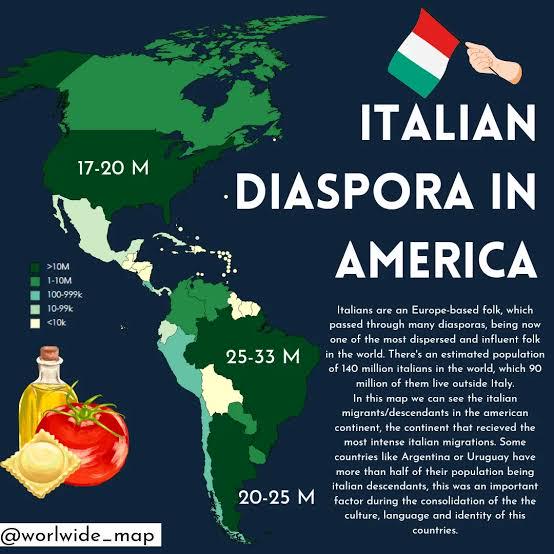Italian Diaspora in the Americas Map


Marcus Rodriguez
Historical Geography Expert
Marcus Rodriguez specializes in historical cartography and geographic data analysis. With a background in both history and geography, he brings unique...
Geographic Analysis
What This Map Shows
The "Italian Diaspora in the Americas" map visually represents the distribution and concentration of Italian descendants across various countries in the Americas. It highlights the historical migration patterns that led to significant Italian communities in nations such as Brazil, Argentina, the United States, and Canada. This map serves not only as a historical record but also as a testament to the cultural and social contributions of Italians in these regions.
Deep Dive into Italian Diaspora
The Italian diaspora refers to the mass migration of Italians, particularly from the late 19th century to the mid-20th century, as they sought better economic opportunities and a more stable life. This movement was primarily driven by socio-economic factors in Italy, including poverty, overpopulation, and political instability. Interestingly, the Italian government actively encouraged emigration during this period, viewing it as a solution to domestic issues.
In the Americas, Italy's influence is profound, with millions of people identifying as Italian or having Italian ancestry. According to estimates, over 25 million Americans claim Italian heritage, making it one of the largest ethnic groups in the United States. The 2010 U.S. Census showcased that states with significant Italian populations include New York, New Jersey, and California. But what’s fascinating is the sheer concentration of Italian descendants in these regions, showcasing how well-established these communities have become over generations.
Brazil and Argentina stand out prominently in this diaspora narrative. Brazil alone is home to over 30 million people of Italian descent, making it the largest population of Italians outside Italy. The states of São Paulo and Rio de Janeiro were heavily influenced by Italian immigrants, primarily during the late 19th and early 20th centuries. Italians contributed significantly to the coffee and agriculture industries, and you can still find neighborhoods, like Bixiga in São Paulo, that celebrate Italian culture through cuisine, festivals, and architecture.
Argentina, on the other hand, has a staggering 62% of its population claiming Italian ancestry, which is a remarkable statistic. The cultural influence is evident in the language, food, and even the arts. The Italian language has contributed numerous words and phrases to Argentine Spanish, and the country hosts the annual "Festa de San Genaro," a festival celebrating Italian heritage.
Regional Analysis
The map delineates not only where Italians settled but also how they integrated into the social and cultural fabric of these countries. In the United States, the Italian-American community has had a profound impact on various aspects of life, from politics to cuisine. The Little Italy neighborhoods in cities like New York, Chicago, and San Francisco are emblematic of this. However, the experience of Italian immigrants in the U.S. varied significantly by region. For instance, while New York offered opportunities in industrial jobs, California attracted Italians to agriculture, particularly in the Central Valley.
In contrast, in South America, the experience was different. The intense European immigration wave in the late 1800s in Brazil and Argentina led to a unique cultural blend. Unlike the U.S., where assimilation often meant adopting English and American customs, in Brazil and Argentina, Italian culture remained vividly alive and was often celebrated openly. Festivals, culinary traditions, and family structures reflect this rich heritage.
Interestingly, the significant Italian presence in Uruguay also deserves mention, where a sizable portion of the population claims Italian roots. This influences not just the cultural landscape but also social norms, arts, and music.
Significance and Impact
Understanding the Italian diaspora in the Americas is crucial for grasping the broader narrative of immigration and cultural exchange. It highlights how immigrants shape and enrich their new countries while retaining ties to their heritage. The Italian influence is not merely historical; it has ongoing implications for identity, community, and cultural preservation.
Current trends show a resurgence of interest in Italian heritage and culture among younger generations, sparking a revival of traditions and culinary practices. With globalization, the connection to Italy is maintained through travel, media, and family ties, ensuring that the Italian diaspora continues to flourish in the Americas.
As we look forward, the impact of the Italian diaspora will likely evolve, adapting to contemporary challenges while preserving the rich legacy of its past. The map serves as a reminder of this enduring connection between Italy and its diaspora, enriching the cultural mosaic of the Americas.
Visualization Details
- Published
- October 8, 2025
- Views
- 32
Comments
Loading comments...